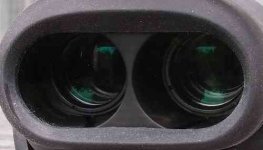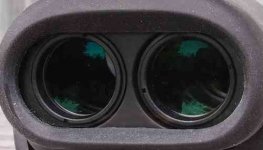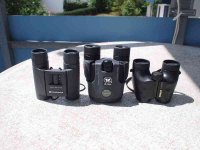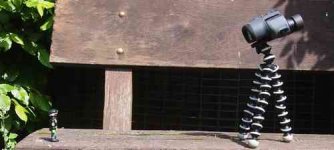oetzi
Well-known member
Experiencing the Papilio II 6.5x21
For several weeks I had the use of a Papilio II. Pentax graciously decided to send me one for a review and, naturally, I choose the 6.5x. Less wobble/swaying at closer distances, bigger FOV and DOF, an easy decision. So all my comments only apply to this model, I havent used any 8x at all.
At first glance, the PII looks big and bulky, compared to other compact bins. But a direct comparison (see picture) did put that into perspective. A 8x22 from Eschenbach and the Nikon CIII 7x21 reverse porro are not that much bigger.
The weight of the PII, sans accessories, is 293gr, thats ok. Carried in its tight-fitting bag( it fits with extended eyepieces) the whole package is compact enough to be put in a jacket´s roomy pocket.
Mechanically the PII delivers. Even though it looks like an all-plastic construction, no faults could be found in these weeks. The hinge shows the right amount of resistance, the dioptre adjustment works faultless, the extendable eyepieces feature solid clicks. Focussing works smooth without any slack and shows the same resistance in both directions.
The focus knob has a small diameter and coupled with the very low resistance when turning, it makes for fairly fast focussing. One full turn to go from 4km down to 1m, another 1 1/3 turn from 1m down to the minimum of 50cm. This means a fine tuning of the focus in what I call the „macro-mode“. It also means lots of turning-the-wheel when all of suden an interest bird shows up in the distance. You win some, you loose some, this is a more specialised bin than all the others.
Optically, the PII ticks the right boxes.
Its a bit warm by comparison with my Nikon EII, still shows the colours in a very pleasant way, no complaints there.
CA are visible. Quite a bit more than with my EII, but even in a typical high-contrast situation (dark branches against a bright sky) they dont bother me.
Sweet spot is about 60%, the zone outside this can not be used to view satisfactorily. for peripherial
use only.
I saw no COF, if there is one, its hidden in the 6.5x´s large DOF.
No stray light or glare worth speaking of. The recssed lenses, the new coating, whatever is responsible, it works.
Focussing is best done on-axis plus 10% of the sweet spot. I noticed a slight detoriation in the precision of the acquired focus when doing it on the outskirts of the sweet spot. It may be my ageing eyes, but in the center it works best.
So optically, the PII shows what you can get by sticking to the porro design. Lots of quality at this low price. That said, the specialization (=macro-mode) of the PII shows in the results. Its great close-up and less than stellar in the distance. Contrast, sharpness, the fine detail, they all suffer on the opposite end of the primary use of the PII.
Close up, everything is great. Lots of sharpness and contrast when doing macro. Be it the fine texure of a spider´s body or the structure of a flower´s pistil, you see it all.
Greater distances are fine, too. For example a pica pica on a roof 100m anway. I could have a fine look at it, with only the 6.5x magnification limitating me in comparison to a good 8x. Likewise a tree line 250m away, everything is fine.
But go the distance and everything changes. having a look at one of my favourite spots, a castle 4km away, showed much detoriation of the visual experience. Less contrast, less sharpness to show the fine details of the walls etc. On a fine, clear day this detoriation could be seen easily. On gloomy, dull, overcast days, this sensation was exaggerated. Maybe the 21mm lenses? A useable bin in these distances, the PII very obviously shows its specialization in macro.
To put these findings into perspective, my Nikon Aculon 7x35 is over all the better binocular. Its big, bulky, heavy and sells for half the price of the PII. But believe me, you dont want to buy the PII solely as a“regular“ bino. I will use it for this, too, because of its inherent portability and because it easily outshines my two other compact bins in every aspect (ergonomics, optics).
So my use of the PII will be twofold. As mentioned, as a carry-along bin when not being out on a purpose. I wont carry one pound+ of glass and metal „just in case“, the PII will do.
This macro mode of the PII its easy to get adicted to it. No limits when getting closer, its the only bin to allow it. I would have to carry a magnifying glass or a camera with macro lens to achieve what the PII offers in its well-rounded package. For me, this Papilio II 6.5x21 is a keeper.
You may consider getting one, too. If only as an alternative to schlepping the big one, or as a supplement to the digiscope/ 10x main optic. The PII will be a worthy acquisitation, I am sure of that. The addiction to going macro comes free and is inevitable.
My german review:
http://www.outdoor-professionell.de/2015/05/test-fernglas-papilio-pentax/
For several weeks I had the use of a Papilio II. Pentax graciously decided to send me one for a review and, naturally, I choose the 6.5x. Less wobble/swaying at closer distances, bigger FOV and DOF, an easy decision. So all my comments only apply to this model, I havent used any 8x at all.
At first glance, the PII looks big and bulky, compared to other compact bins. But a direct comparison (see picture) did put that into perspective. A 8x22 from Eschenbach and the Nikon CIII 7x21 reverse porro are not that much bigger.
The weight of the PII, sans accessories, is 293gr, thats ok. Carried in its tight-fitting bag( it fits with extended eyepieces) the whole package is compact enough to be put in a jacket´s roomy pocket.
Mechanically the PII delivers. Even though it looks like an all-plastic construction, no faults could be found in these weeks. The hinge shows the right amount of resistance, the dioptre adjustment works faultless, the extendable eyepieces feature solid clicks. Focussing works smooth without any slack and shows the same resistance in both directions.
The focus knob has a small diameter and coupled with the very low resistance when turning, it makes for fairly fast focussing. One full turn to go from 4km down to 1m, another 1 1/3 turn from 1m down to the minimum of 50cm. This means a fine tuning of the focus in what I call the „macro-mode“. It also means lots of turning-the-wheel when all of suden an interest bird shows up in the distance. You win some, you loose some, this is a more specialised bin than all the others.
Optically, the PII ticks the right boxes.
Its a bit warm by comparison with my Nikon EII, still shows the colours in a very pleasant way, no complaints there.
CA are visible. Quite a bit more than with my EII, but even in a typical high-contrast situation (dark branches against a bright sky) they dont bother me.
Sweet spot is about 60%, the zone outside this can not be used to view satisfactorily. for peripherial
use only.
I saw no COF, if there is one, its hidden in the 6.5x´s large DOF.
No stray light or glare worth speaking of. The recssed lenses, the new coating, whatever is responsible, it works.
Focussing is best done on-axis plus 10% of the sweet spot. I noticed a slight detoriation in the precision of the acquired focus when doing it on the outskirts of the sweet spot. It may be my ageing eyes, but in the center it works best.
So optically, the PII shows what you can get by sticking to the porro design. Lots of quality at this low price. That said, the specialization (=macro-mode) of the PII shows in the results. Its great close-up and less than stellar in the distance. Contrast, sharpness, the fine detail, they all suffer on the opposite end of the primary use of the PII.
Close up, everything is great. Lots of sharpness and contrast when doing macro. Be it the fine texure of a spider´s body or the structure of a flower´s pistil, you see it all.
Greater distances are fine, too. For example a pica pica on a roof 100m anway. I could have a fine look at it, with only the 6.5x magnification limitating me in comparison to a good 8x. Likewise a tree line 250m away, everything is fine.
But go the distance and everything changes. having a look at one of my favourite spots, a castle 4km away, showed much detoriation of the visual experience. Less contrast, less sharpness to show the fine details of the walls etc. On a fine, clear day this detoriation could be seen easily. On gloomy, dull, overcast days, this sensation was exaggerated. Maybe the 21mm lenses? A useable bin in these distances, the PII very obviously shows its specialization in macro.
To put these findings into perspective, my Nikon Aculon 7x35 is over all the better binocular. Its big, bulky, heavy and sells for half the price of the PII. But believe me, you dont want to buy the PII solely as a“regular“ bino. I will use it for this, too, because of its inherent portability and because it easily outshines my two other compact bins in every aspect (ergonomics, optics).
So my use of the PII will be twofold. As mentioned, as a carry-along bin when not being out on a purpose. I wont carry one pound+ of glass and metal „just in case“, the PII will do.
This macro mode of the PII its easy to get adicted to it. No limits when getting closer, its the only bin to allow it. I would have to carry a magnifying glass or a camera with macro lens to achieve what the PII offers in its well-rounded package. For me, this Papilio II 6.5x21 is a keeper.
You may consider getting one, too. If only as an alternative to schlepping the big one, or as a supplement to the digiscope/ 10x main optic. The PII will be a worthy acquisitation, I am sure of that. The addiction to going macro comes free and is inevitable.
My german review:
http://www.outdoor-professionell.de/2015/05/test-fernglas-papilio-pentax/
Attachments
Last edited:










